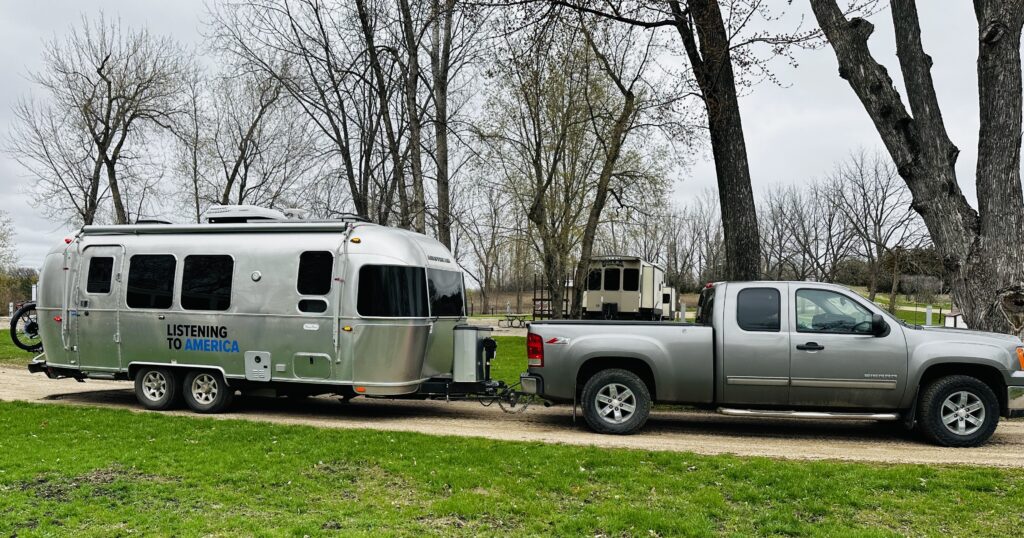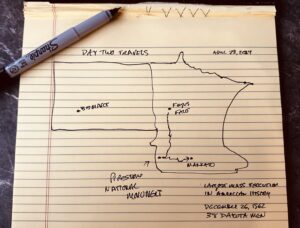Clay leaves his home in Bismarck, North Dakota, and heads east on a circuitous route to Sag Harbor where John Steinbeck began his famous 1960 cross-country journey, immortalized in Travels With Charley.

Over the next few months, Clay will shadow Steinbeck’s 10,000-mile trek around the USA (and make a few detours of his own). Clay’s expedition is a central part of LTA’s big initiative to explore the country and take the pulse of America as it approaches its 250th birthday. Be sure to follow Clay’s adventures and subscribe to our newsletter.
Sunday, April 28, 2024 — Well, I’m underway! After somehow managing to assemble a bike rack for my Listening to America Airstream (five hours, the worst instruction manual, bruised knuckles, and several bleeding injuries to my fingers), I locked the front door of my house. “Nothing to do now except go,” I said out loud. It was a chilly and still wintry morning in Bismarck, temperature 42, brisk wind, gray skies. I gassed up in the nearby village of Stirling, then drove nonstop to Fargo, North Dakota where I bought gas and a bag of pretzels. In mid-afternoon, I drove southeast to Fergus Falls, Minnesota, found the Swan Lake Resort, and checked in. The owners were at the lakeside putting docks into place for the summer. I could have stolen sundries, decals, patches, mugs, and t-shirts from the deserted office. Thoreau wrote, “I think we may safely trust a good deal more than we do.”
I chose Fergus Falls for my first stop because it was a moderate distance from Bismarck (262 miles) and because my maternal grandparents had a dairy farm here in the 1950s, ’60s, and ’70s. I don’t know what they would have thought of my career, but they would have been astonished that one can live a whole life without doing any real work. They worked hard every day of their lives; even on Sundays, the steers needed feeding, and the cows had to be milked, all 16 of them, with names like Petunia, Daisy, Whitey, Pal, and Blossom. They would have shaken their heads at the sight of a gleaming Airstream trailer. They seldom traveled far beyond Otter Tail County, Minnesota. They drove once to California, where they were fish out of water at Disneyland and on the LA freeways.
At the “Compass” site at Swan Lake Resort, once I got the rig hooked up to water and electricity, I began to unpack and find places in the cabinetry for clothes, electronic equipment, books (11), food, toiletries, notebooks, and other necessities. The camp hosts had invited me to supper (in the rural Midwest, dinner is served at mid-day), but I declined because I needed to get everything settled in the rig. But — in Steinbeck fashion — I invited them to stop by later. They did, about 8:45 p.m. They lit a fire in the firepit. They brought local beer and a half bottle of whiskey. They are young — in their later 30s. Anna had her 11-month-old baby swaddled in her arms. Tom served as drinkmaster. Anna brought a plate of outstanding carrot cake.
We talked for a couple of hours. About their decision to leave corporate America to buy a modest resort in a place where they had no kin. About the essential goodness of the people who come stay here. The resort doesn’t allow flags at the campsites, so they have no way to know people’s politics and generally avoid the topic. They wanted to know about my ambitious journey. I explained my quest. This led to a discussion of the State of the Nation as we approach America’s 250th birthday. They were thoughtful. Tom’s well-read and ready to talk.
Eventually, the fire subsided and we were all cold (except for the swaddled baby), so we called it a night. I tumbled into bed.

Day Two Begins
It’s a gray morning in northwestern Minnesota, but so far dry, 42 degrees, some wind in the still-bare trees. I’ll pack up soon and head to Mankato, 212 miles south. I want a full day here to finish unpacking and do some writing, but I’ve got to keep moving if I am going to get to the eastern tip of Long Island within 10 days.
Immediate conclusions:
1. Setting up camp only takes about 10 minutes — hose to the spigot, stout electrical cord into the gray metal box.
2. Nothing had tumbled around in the Airstream on a blustery day of driving with many road bumps and potholes. If you pack it right, there is no chaos upon arrival.
3. Driving a pickup-RV combination 60 feet long requires concentration (no texting!), and a few hundred miles will wear you out.
4. Given the spontaneous little party we scared up at my fire pit, and the quality of the conversation, I reckon that it’s going to be easy enough to Listen to America.
My Itinerary: Phase One: April 27-June 6, 2024
My plan is to drive about 250 miles per day. My intrepid scout Frank is getting me reservations in campgrounds. Months ago, I provided him with an elaborate set of criteria for choosing locations: county and state parks wherever possible and non-chain commercial campgrounds, unless KOA is the only option. I’ll spend at least one or two nights in Walmart parking lots. Connectivity matters! I’ll be posting photos and commentary virtually every day.
The plan looks like this. Get to the starting gate at Sag Harbor on Long Island: Bismarck to Fergus Falls, Minnesota; Fergus Falls to Mankato, Minn.; Mankato to Cedar Rapids, Iowa; Cedar Rapids to Ottawa, Illinois, home of my friend WGN Chicago radio talk show host John Williams, the brainiest of AM talk show hosts; Ottawa to Big Bone Lick, Kentucky, where Jefferson’s proteges Meriwether Lewis and William Clark dug up mastodon bones for the entry museum at Monticello; Big Bone Lick to Bethany, West Virginia, where I will interview the “bad boy of Steinbeck studies,” Bill Steigerwald, author of Dogging Steinbeck: Discovering America and Exposing the Truth about Travels with Charley; Bethany to Pennsylvania; Pennsylvania to Long Island, New York. I’ve studied his book carefully and printed out his blog prose from his 2010 50th anniversary retracing of Steinbeck’s 1960 journey. Steigerwald did important field research and concluded that:
A: Steinbeck embellished and even fictionalized some of Travels with Charley (TWC).
B: He actually stayed in his truck camper less often than he would have you believe.
C: His wife Elaine was with him for about 40% of the time, a fact he suppressed to keep up the appearance of a lonely journey through the heart of America.
D: He raced through long stretches of the journey to rendezvous with Elaine.
E: He didn’t always sleep where he said he did.
F: Although he said he had to travel incognito so that his fame would not distort the process, he used his celebrity when it was important.
I disagree with many of Steigerwald’s conclusions, and I think his mistook a work of travel literature by demanding punctilious and verifiable reportage. However, he has provided all future Steinbeck re-tracers with an excellent day-by-day guide to what Steinbeck saw and did.
The cad! Steigerwald wrote me an email saying that I could park in his driveway and if I needed a hot shower or a comfortable bed, I could be a guest in his house. I wasn’t born yesterday, Bill. I wrote back to say he was trying to lure me inside his house so that he could later denounce me for embellishing and fictionalizing my own journey! That, of course, was not his intention, but you cannot trust a muckraker on a journey like this.
When I finally reach Sag Harbor on the far end of Long Island around May 10, the actual Steinbeck journey begins.
In a nutshell: through New England to the top of Maine, which he insisted on touching so I will, too; then down through New Hampshire and Vermont to the Erie Canal, which I have always wanted to see; Niagara Falls; then along the underside of the Great Lakes to Chicago, where I will stay in the Ambassador East Hotel, where Steinbeck’s wife Elaine met him for a few days; then through Wisconsin and Minnesota (with stops at Sinclair Lewis’ Sauk Centre, and Frazee, where Steinbeck camped among a sea of turkey farms and Lake Itasca, the “true source” of America’s greatest river the Mississippi); and finally back to Bismarck.
Phase Two: July-August 2024
After a few weeks at or near home, I’ll start Phase Two in late July. In a tinier nutshell: Bismarck through Montana, Idaho, and Washington to Seattle; Seattle to Monterey but with plenty of time in the Redwoods; Salinas, home of the National Steinbeck Center; then on to Tehachapi Pass, from which the weary but hopeful Joads looked down into the lush Central Valley of California; to Flagstaff and Route 66; and ending in Amarillo, Texas, where Steinbeck spent what he called an “orgy” of Thanksgiving abundance at a ranch where his wife Elaine had connections.
Phase Three: October-Thanksgiving
Phase Three: Amarillo to Austin; Austin to New Orleans, where Steinbeck observed anti-integration protests that sickened him; and then up the East Coast to New York City, with a serious tour of Civil Rights sites in Alabama, Mississippi, and Louisiana (Selma, Montgomery, Birmingham, possibly Atlanta). I’ll also stop at Jefferson’s Poplar Forest in Lynchburg, Virginia, and, of course, Monticello at Charlottesville.
The whole journey will take about 20 weeks. I’m reading Steinbeck’s works along the way. (This morning, I started reading his first novel, Cup of Gold.) I’ll be posting dispatches and photos virtually every day. My friend Russ Eagle (a Steinbeck scholar) will host Listening to America podcasts from North Carolina while I sit at this dinette desk in the Airstream.
I’ve got to stop, for now, stow everything away, and get on the road. “I have miles to go before I sleep and promises to keep.”
But I’m now officially underway. And I’m so glad you are along for the adventure.
